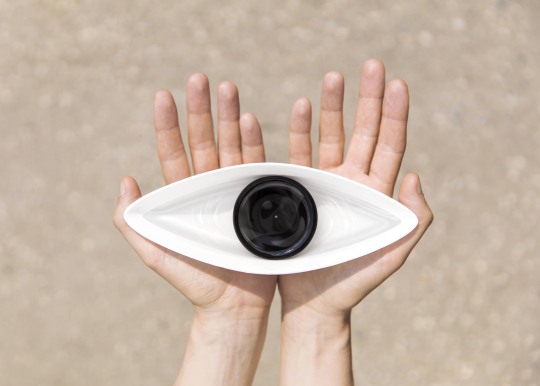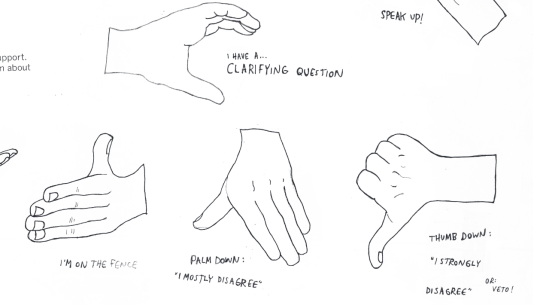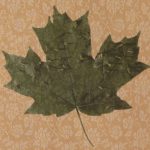Conversations | The Study Center for Group Work
This NYFA Arts Business Incubator member cultivates behaviors that allow groups to work together.
The Study Center for Group Work is both an online resource and an in-person network of people who meet to refine their collaborative methods with one another. Part of NYFA’s Arts Business Incubator’s second cohort, the business facilitates group work through lesson plans, readings, and objects; gatherings for artists to share resources; and accessible public trainings in methods of listening, attention, and collaboration. We recently spoke with founder Caroline Woolard to learn more about The Center’s work and what’s in store this Fall.
NYFA: How’d the idea for The Study Center for Group Work come about?
Caroline Woolard: I believe that group work is both the most necessary and the most difficult endeavor of our time. It is through collaboration—through dialog and debate across differences of opinion, experience, and expertise—that strong ideas emerge. But most people have no experience of democracy at work, at home, in school, or online. So how can we learn to collaborate? How do we develop a musculature of shared decision making and of shared work?
I have been in so many groups where communication breaks down; where people focus on logistics and strategy rather than the interpersonal skills of listening, attention, and communication.
A few years ago, I began to notice that many visual artists had developed methods of listening and group work. Yet they did not have a way to share their work with one another or with the public. Just as dancers take classes throughout their lives, more and more visual artists are committed to group work through daily practice. If democracy is an endless conversation, then The Study Center for Group Work aims to cultivate behaviors that allow groups to work together. You can see a full list of the artists who have contributed to this resource here.
NYFA: What sorts of experiences and techniques can organizations and people take away from The Study Center?
CW: I hope that teachers, art spaces, collectives, worker-owned businesses, art classes, and working-groups will use this online library of collaborative methods that have been recommended by artists. These methods often embrace the unknown, encouraging people to listen deeply enough to be transformed. For example, here are some methods for:
- group functioning (Asset Mapping) (Diagram Hacking)
- role clarification (Threeing) (Questions for Schematic Theater)
- communication (Intergroup Dialog) (A Field Guide to Spatial Intimacy) (Hand Signals)
- conflict resolution (Shark, Owl, Turtle, Teddy Bear, Fox)
I invite you to learn about collaborative methods, to access teaching resources, and to see the schedule for upcoming events and jobs related to collaboration.

NYFA: Can you tell us more about the program’s 2016 beginnings at Cooper Union?
CW: I ran a pilot program that took the form of an exhibition called WOUND: The Study Center for Group Work, curated by Stamatina Gregory, at Cooper Union in 2016-2017. WOUND was written up in The New York Times, Art in America, and Artforum; we knew it needed to continue. You can see a video from that show here.
WOUND asked: How, through collaboration, can we unwind time in order to render it open, unspecified, and inviting? How can we recognize the nature of our seemingly dwindling attention not as the result of being “wound up,” but as the result of being hurt or injured, an emotional claim which, necessarily, implies the ability to be healed? Can these practices render time a qualitative not quantitative phenomenon, something that is marked and construed for groups through mutuality rather than received through authority?
The pilot confirmed my belief that art and artistic practices can facilitate community cooperation. Great art allows people to move from vision to action, to externalize ideas in concrete objects. To embody collaborative time, groups must learn how to gather, how to need and support one another, and how to tremble together.
Many of the practices presented in this study center acknowledge the deep hurt or wounds from which political action, artistic collaboration, and transformative organizing often begin. Examples include Ultra-red’s protocols, which emerged from HIV/AIDS organizing; taisha paggett and Ashley Hunt’s work that unfolds from our current epidemic of mass incarceration; and Shuan Leonardo’s I can’t breathe, which was created as a response to mass police-sanctioned violence against communities of color. These artists’ and groups’ practices are lifelong and acknowledge that wounds cannot be healed within the temporality offered by conventional art institutions.
NYFA: What brought you to NYFA’s ABI program? What’s your experience been like so far?
CW: I came to ABI because I believe that all artists should be taught accounting and basic business skills in art school, but we are not. How are artists supposed to create conceptually rigorous work without understanding the systems—financial and legal—that enable their work to circulate in the world? Further, in a country that does not tax the rich in order to provide money for basic common goods like education, health care, and art for all people, why should I wait for philanthropists to make money and redistribute a small portion back to the commons? Why not learn how to run a business and do so in an equitable, socially-just manner?
So far, I have learned from incredible members of the cohort, as well as mentors who have provided workshops on everything from accounting to business modeling. I am excited to see where the other groups go in years to come.

NYFA: What’s next for The Study Center?
CW: Here are a couple upcoming, free workshops in New York City:
Program Date: Thursday, September 14, 5:30 PM – 7:30 PM
Location: Brooklyn Commons: 388 Atlantic Avenue, Brooklyn, NY 11217
About: Project404 is a practice of attention that aspires to help us remain fully, creatively engaged with the world and with ourselves while using the very devices that threaten us with distraction.
RSVP: [email protected]
Program Date: Saturday, September 30, 3:00 PM – 5:00 PM
Location: Spaceworks @ Williamsburgh Library, 240 Division Avenue, Fl. 2, Brooklyn, NY 11211
About: This workshop looks at the ways in which we meet our needs for wellbeing in order to dream, practice, and work on any project.
RSVP: Here
In addition to the above, The Study Center for Group Work artists Chloë Bass, Shaun Leonardo, Asha Veal Brisebois, and I will participate in the Dakar Biennial this May. We’ll display sculptural tools that have been made for facilitation, listening, attention, and collaboration with performance workshops facilitated by Bass, Leonard, and Veal Brisebois that will spur dialog around one-on-one social interactions; the criminal justice system; and information-sharing among artists, managers, and theorists.
– Interview conducted by Amy Aronoff, Communications Officer
Learn more about NYFA’s Arts Business Incubator and sign up for our free bi-weekly newsletter, NYFA News, to receive updates on future programs and articles about artists and arts entrepreneurs.
Images from top: Ways of Being (Support) by Caroline Woolard, Emilio Martinez Poppe, Susan Jahoda; Caroline Woolard, Eye Amulet, 2017, porcelain and water, Photo Credit: Levi Mandel; and Hand Signals by Douglas Paulson and Kerry Downey. Video: Herman Jean-Noel and Neglakay Productions.





